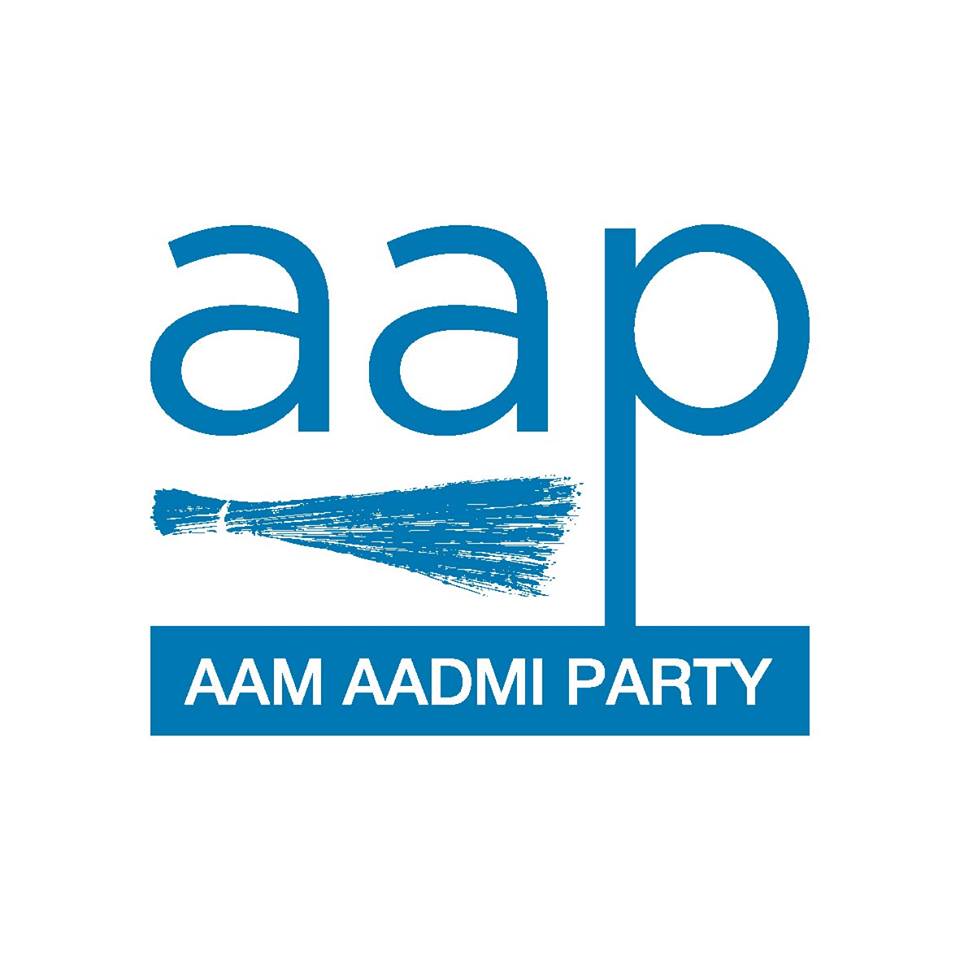

All Rural households in Delhi have been connected to the piped water network.
By connecting the erstwhile unconnected houses in the villages of Badarpur Khadar, Daraula and Ghalibpur, the Delhi government has provided tap water connections to all rural households in the capital. The connections have been provided under Jal Jeevan Mission. With this feat Delhi has joined a select group of states/UTs that have achieved 100% target of connecting all rural households.

Making Delhi self-sufficient in water
The AAP government is working towards making Delhi self-sufficient in water through a 3-pronged strategy that includes
- constructing underground reservoirs to store flood water
- storing rainwater in various places in Delhi to enhance the groundwater level
- treating sewage water and storing the water in local ponds.
“The government does not want to depend on other states for the city’s water needs. It is working on projects to ensure that water availability in Delhi will be more than its demand in the next few years.” – Arvind Kejriwal, Delhi CM
The Delhi Jal Board (DJB) operates nine water treatment plants at Wazirabad, Chandrawal, Haiderpur, Sonia Vihar, Bhagirathi WTP, Okhla, Nangloi, Dwarka and Bawana to supply 935 MGD potable water every day.
The DJB supplies around 935 MGD water against the demand of 1,140 MGD.
- Delhi will get another 50 MGD of water from Himachal Pradesh by December 2022.
- Will start drawing 25 MGD from the reservoirs created in the Yamuna floodplains to retain excess water in the monsoon season.
- Around 200 MGD of groundwater will be extracted from areas with high water tables, such as Roata in Najafgarh.
Thus Delhi will have 1,305 MGD of water available to meet the demand of its residents by March 2025.
By 6th Dec 2021, the DJB has started installing bore wells in selected areas of Delhi to augment the water supply. Each well is expected to yield about 1 MGD (46 lakh litres per day).

A> Recharging Water Tables Through Yamuna Flood Plains
Groundwater recharge through Yamuna floodplain project
The Yamuna Floodplains project at Palla aims at conserving water in the Yamuna floodplains.

(Source: The indian Express – Link)
Mega reservoirs between Palla and Wazirabad in 1,000 acre of area to be set up. This would be accomplished via creation of small ponds in the floodplains that will catch water from an overflowing Yamuna during the monsoon.
Ground Water level analysis in September 2020 showed that the groundwater table has risen by nearly 5 feet at Yamuna Floodplains.
In the year 2019, a 17.6 acre pond was built in Palla village. With just one pond, the water level in the area increased by 1 to 1.3 metres.
In 2020, the area of the pond was increased to 26 acres by taking a total of 43 acres of land. With that, the groundwater level increased by 2.5 metres that year.
A total of 35 piezometers have been installed to measure the rise in groundwater levels during the flooding cycles.
A 2-year pilot ground water recharge project that started in Aug 2019 in Sundarpur Village is near completion. Shallow reservoirs of 1200 acres were envisioned across Delhi, of which the 40 acres pilot has now been implemented. 33 piezometers were installed and a 2.35 metres (7 feet) rise in water table was observed post monsoon 2021. This reservoir will benefit 70,000 people living in the vicinity. The water table that was going down at the rate of 0.2 m per year in the last few years has now started to increase.
Delhi government will create a 459-acre reservoir in the Yamuna floodplains upstream of the Wazirabad barrage and a 20-acre off-river mini reservoir to store flood water during the monsoon season which can be used to augment water supply in the national capital, an official statement said on 25th Feb 2022.
If the project yields desired results, 20 reservoirs of 200 acres each and 20 off-river mini reservoirs of 100 acres each will be created in the river floodplains upstream of the Wazirabad barrage, it further said.
“Our plan is to store the floodwater during the monsoon season in reservoirs (upstream of Wazirabad Barrage) and purify it for the people of Delhi. Once this strategy is successful, more such reservoirs will be built to divert excess water from the Yamuna for water supply in Delhi,” Chief Minister Arvind Kejriwal said on 25th Feb 2022 after chairing a high-level meeting to discuss plans to augment water supply.

B> Storing rainwater in various places in Delhi to enhance the groundwater level

Rainwater Harvesting (RWH) Campaign
As a part of the 24X7 water supply project, DJB launched the Rainwater Harvesting (RWH) campaign “30 days, 200 structures” in Dec 2020.
The campaign aims to encourage people to build rainwater harvesting systems in their buildings, especially hospitals, education institutes, shopping malls, large residential apartments, commercial spaces etc.
42 zonal officers have been entrusted with leading the initiative in their respective areas in terms of persuading individuals and institutions.
As of 14th Mar 2021, the Delhi Jal Board had installed a rainwater harvesting system in 585 of its 771 installation projects.

RWH made mandatory for 100 sq metre houses
On 20 Jun 2021, with an aim to increase depleting groundwater levels in Delhi, Rain Water Harvesting (RWH) has been made mandatory on 100 square metre houses.
With the installation of RWH systems in buildings on a 100 square metre house, about 8 to 10 lakh houses are expected to be covered.
The last date for the implementation of the RWH provisions was extended till December 31, 2021. Also, it will no longer be mandatory to take DJB certification for rainwater harvesting systems from now on.

Modern extraction wells
As of 8th Dec 2021, the DJB has installed 30 “modern extraction wells” near the Sonia Vihar water treatment plant , and 70 more such structures are in the pipeline to augment water supply in the city.
These “modern extraction wells” can provide 6-8 times more water than ordinary wells. The capacity of each well is to supply 1.2-1.6 million gallons of water per day (MGD).
This will help resolve the problem of drinking water in east Delhi areas.
Ordinary wells have a diameter of 0.3 metre while these new wells have a diameter of 1-1.5 metres and a depth of 30 metres. Removal of water from modern wells will not have much effect on the groundwater level. Cost of the new WTP will be saved.
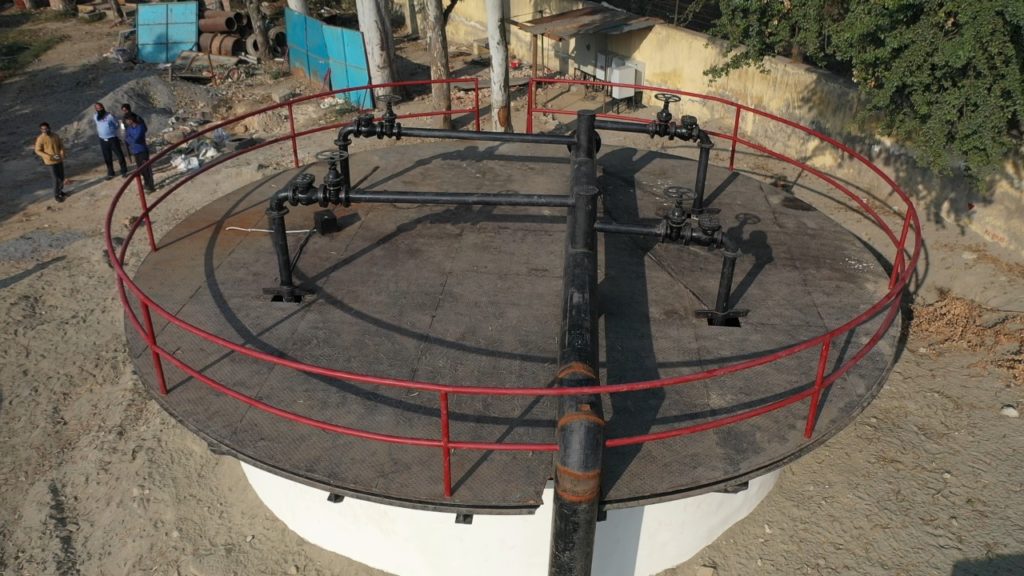
(Source: Tweet by Satyendar Jain)

C> Treating sewage water and storing the water in local ponds

WTP at Coronation Pillar
This project, the first ever of its kind in India, will give an additional 95 MGD of water by December 2024.
The high-quality treated sewage water from the Coronation Pillar Water Treatment Plant would be taken to Palla and dumped into the Yamuna. The diluted water would then be lifted again 11 km downstream in Wazirabad for further treatment.
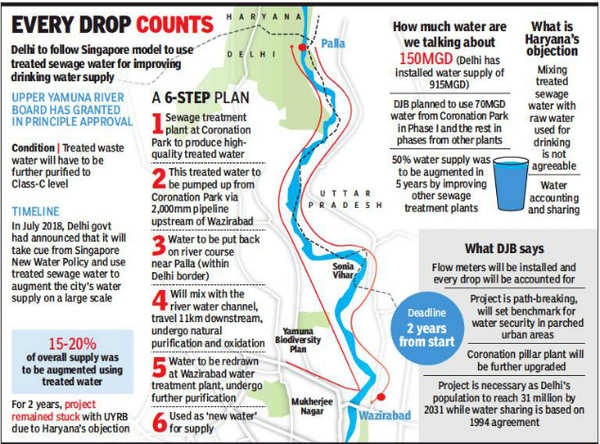
(Source: Times of India – Link)

Underground Reservoirs (UGR)
On 2nd Mar 2022 Water Minister Satyender Jain inaugurated a massive underground reservoir with a capacity of 2.95 Cr litres in Mundka Village to curb the water crisis of the area. This UGR will ensure smooth water supply to residents of 5 unauthorised colonies & villages of Mundka Constituency.
On the same day, he also inaugurated an underground reservoir with a capacity of 2.68 Cr litres in Sonia Vihar. This UGR will benefit approx. 6 lakh residents of East Delhi and solve the existing water crisis by increasing the water pressure in the entire area.
On 3rd Mar 2022, another UGR with a 1.24 Cr litres capacity was inaugurated in Mayapuri. This will benefit approximately 1.5 lakh residents of Hari Nagar and Delhi Cantonment.

Single Window Facility to all DJB Consumers
On 17th Nov 2021, a Single window facility to all DJB (Delhi Jal Board) consumers was unveiled. Installing new water connections, including getting water meters has been made easy. The procedure for maintaining existing water connections has also been simplified. The revised tariff is:
- Category A B C: Rs. 4000/-
- Category D E: Rs. 2000/-
- Category G H: Rs. 1000/-

Delivering clean and safe water to homes
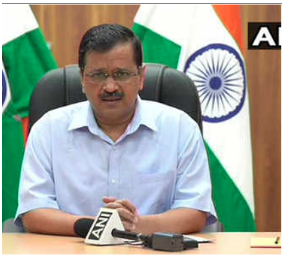
“I want every Delhiite to have access to 24X7 clean and safe water in the future.” – Arvind Kejriwal, on Jan 14, 2021, when chairing a high-level review meeting of the DJB including those for 24×7 water supply and establishing 100% water sewer connections across the city. (Link)

Delivering RO Water to Homes
In Sep 2021, the AAP government announced that Reverse Osmosis Plants would be set up to treat saline groundwater, where the groundwater level is high but TDS (Total Dissolved Solids) count is also high. The RO plants will purify groundwater and supply it to households using the Delhi Jal Board’s (DJB) existing pipelines.
7.25 lakh people (mostly residing in slums) will benefit from 5 RO plants in the first phase of implementation.
- Okhla – 136 MLD (Million Litres Per Day)
- Dwarka – 68 MLD
- Nilothi-Nangloi – 68 MLD
- Chilla – 45 MLD
- Najafgarh – 45 MLD
One small RO plant is set to come up for every 500 households. For every jhuggi, one RO plant will be set up, and more than one would likely be set up for areas where the population is over 2,000.
The government will give a plan to set up RO plants to private players. The water that will meet stipulated standards will be bought by the government at a cheap rate.

Ammonia Removal Plants
On 20th Aug 2021, DJB’s first ammonia removal plant with a capacity to treat 1 million gallons water per day was made operational in a ranney well near Vikas Marg. The plant would be sufficient for providing water to 7000 families as it would add clean water directly to the underground reservoir.
More such plants are being installed across the capital for augmenting water availability.
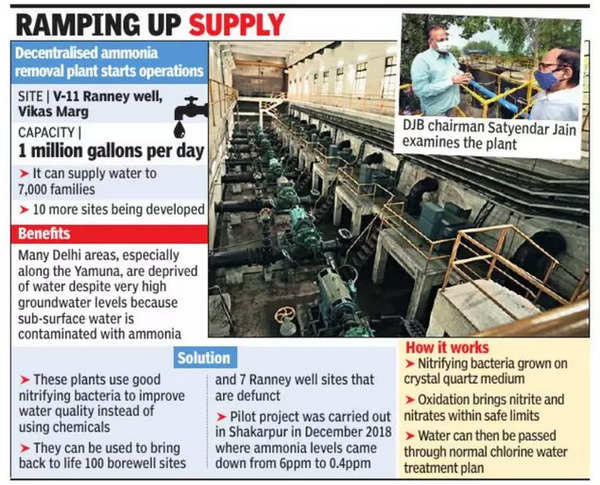
(Source: Times Of India – link)


